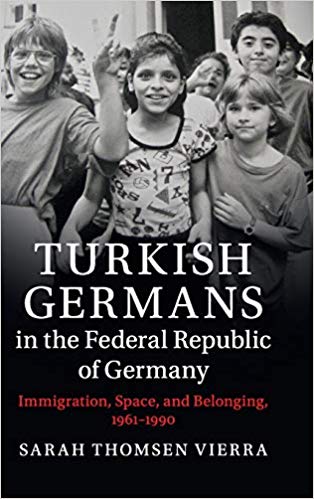
Turkish Germans in the Federal Republic of Germany: Immigration, Space, and Belonging, 1961-1990 by Sarah Thomsen Vierra

How is integration measured? Turkish Germans are ubiquitous in the Federal Republic of Germany. Scholars, journalists, policy makers, and ordinary citizens comment on their visibility, their roles, their relationships in neighborhoods, as well as their participation in schools, community centers, and other social, religious, and cultural institutions. In this book, Sarah Thomsen Vierra welcomes readers into the Sprengelkiez—a densely populated and diverse neighborhood in Berlin’s Wedding district—for a close look at spaces of belonging. Over the course of her book, she demonstrates that “Turkish-German” is a false dichotomy, especially because personal and community interactions are constant. Thomsen Vierra poses important questions: Where does the conflicted sense of belonging come from for Turkish-Germans? How do they manage their hybridity?
One of the book’s key points is that integration is a spatial process best viewed through persons’ interactions with their neighbors, with diverse ideas, and within their environments. These interactions can be coalitions or simply close relationships. Careful to not be overly sanguine, Thomsen Vierra offers an honest view from the perspective of the state, neighborhood and community groups—both secular and religious—and from individuals. The study’s main intervention in the scholarship is a conversation about the difference between “belonging” (as how much individuals feel they belong) and “integration” (how much state institutions think they belong). Thomsen Vierra’s goal is to highlight the creation of what she calls “belonging” in the quotidian moments of individual agency, although an explicit definition of what it means to belong would have been useful. The “agency versus structures” debate in the scholarship—how much control an individual has versus imposed structural limitations—is part of an exciting new wave of scholarship on ethnic minorities in Europe (De Bock 2018). While a bottom-up approach supported by oral histories is not new, the focus on the varied spatial relationships and sites of belonging in a small group provides an important new case study. The close look at a particular population, a neighborhood—in contrast to a federal or continent-wide study—can draw different and novel conclusions by simply changing the context.
The book moves through examinations of distinct spaces—the workplace, the home and housing, the neighborhood, schools, and religious sites—culminating with a discussion of post-unification Germany. Dovetailing with other bottom-up scholarship, especially studies of foreign labor activism, Thomsen Vierra concurs that the workplace has been an important site of interaction and negotiation that balanced individuals’ choices with the obligatory (Bojadzijev 2007; Miller 2013). The workplace has also been important in the creation of social networks that eased adjusting to life in Germany. The book adds to the scholarship with a move away from German workplaces to Turkish-run businesses and family spaces—a welcome addition. When shifting to housing, the book addresses generational differences, differentiating itself from other studies that have used housing to determine integration by seeing the home as a place where an important generational shift occurs from the first to the second generation (61). Thomsen Vierra defines home more broadly than as a single household and includes extended families, friends, and acquaintances; in this sense home has myriad connections with its surroundings—the neighborhood. Thomsen Vierra argues that Turkish Germans, especially the second generation, made and continue to make space for themselves—for example through their participation in community centers—and, therefore, have played an active role in defining belonging on their own terms (113).
As the number of immigrants in the neighborhood increased relative to German residents, German discourses progressively believed there was a “foreigner problem,” placing the onus of belonging solely on the newcomers. A good case study for this demographic change over time in a secular space is the school system, wherein Vierra analyzes the evolution of expectations and responsibilities for the expansion of the Turkish German community. Throughout the book, there is an excellent analysis of how cultural differences has defined gender relations within the family and neighborhood context. First generation women, who married into a life in Germany, found, like their German counterparts, the home to be a site of demands, unequal labor, and constant negotiation with their husbands (70-72). Gendered expectations for daughters and sons have also been a significant factor in the generational shift that Thomsen Vierra incisively navigates throughout the book. In the case of second-generation education, Thomsen Vierra notes that despite success stories, some Turkish schoolgirls’ families considered school to be unnecessary or a distraction from family duties (130-31). The school system, from primary schools through community education centers (Volkshochschule), was also significant because it played a large role in self-definition toward and against the majority society on the familial, individual, and institutional level.
In contrast to these secular spaces of interaction are religious spaces such as mosques and Koran schools. Thomsen Vierra examines how these spaces were created for and by the community as it engaged in larger, national debates about how religion does and ought to shape Turkish-German communities. Places of worship center a community religiously, socially, and culturally. For decades, Berlin mosques were rarely visible despite the outsized role they played in media, government, and academic attention to Muslim populations and their visibility. Considering mosques the “architectural version of the headscarf” that illustrate Islam’s spread in Germany’s neighborhoods (165), she looks equally at how Turkish Muslims created spaces of belonging in these communal centers and at the media’s presentation of concerns about how these same spaces impacted integration into a narrowly defined “West German society.”
The book moves beyond community generational differences and local spaces to the temporal by considering change over time. Here, the author considers how time creates defining spaces such as borders, namely those constructed and destroyed with the end of the Cold War. Constructed spaces (such as the political borders between “East” and “West”) have an inescapable historical significance worldwide. These considerations complement others about how the post-Cold War era did and did not impact the integration efforts of preceding decades (Chin 2017). As with the neighborhood view from decades earlier, Thomsen Vierra’s examination of the turn from the 1960s to the 1990s also takes a ground up view of how Turkish Germans in the new Germany responded to an economic downturn that hit them proportionally hard. Some opened their own businesses while others joined street gangs that targeted Neo-Nazis and allowed them to assert dominance over their territories. While these groups chose opposite directions, both put down roots and invested in their spaces in their own ways. In this period, both classrooms and mosques took overt measures to address previous shortfalls in integration and community needs. Thomsen Vierra illustrates how economic, social, and cultural developments-—many started in the 1970s —matured into the 1990s debates and violent acts around concepts of belonging.
This book would be of interest to a wide audience. It is thoroughly researched and accessible with interesting narratives that would fascinate students and scholars alike. One thing that might have made the book stronger would have been to look at the outliers in the community, for example the secular Turkish community, and those with greater ties beyond the neighborhood to have an even richer consideration of integration’s development over time. The book’s strength is in its intense focus on a specific location and on small scale integration. Thomsen Vierra provides a rich and fascinating window into a community she knows well and her context elucidates national debates in important new ways.
Jennifer Miller is Associate Professor of Modern European History, Director of European Studies, and Graduate Director at Southern Illinois University Edwardsville. She is the author of Turkish Guest Workers in Germany, Hidden Lives and Contested Borders, 1960s-1980s and other publications on ethnic minorities in Europe.
Turkish Germans in the Federal Republic of Germany: Immigration, Space, and Belonging, 1961-1990
Edited by Sarah Thomsen Vierra
Publisher: Cambridge University Press
Cloth / 269 pages / 2018
ISBN: 9781108691475
[1] Manuela Bojadzijev. Die windige Internationale: Rassismus und Kämpfe de Migration. Munster: Westfälsches Dampfboot, 2008.
[2] Jozefien De Bock. Parallel Lives Revisited: Mediterranean Guest Workers and Their Families at Work and in the Neighborhood, 1960-1980. New York: Berghahn, 2018.
[3] Jennifer A. Miller. “Her Fight is Your Fight: ‘Guest Worker’ Labor Activism in the Early 1070s West Germany.” International Labor and Working-Class History. Cambridge: Cambridge University Press. Vol 28, 2013:226-247.
Published on March 10, 2020.




